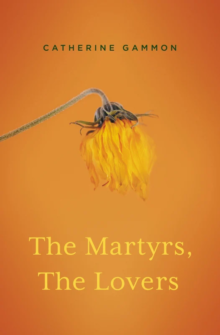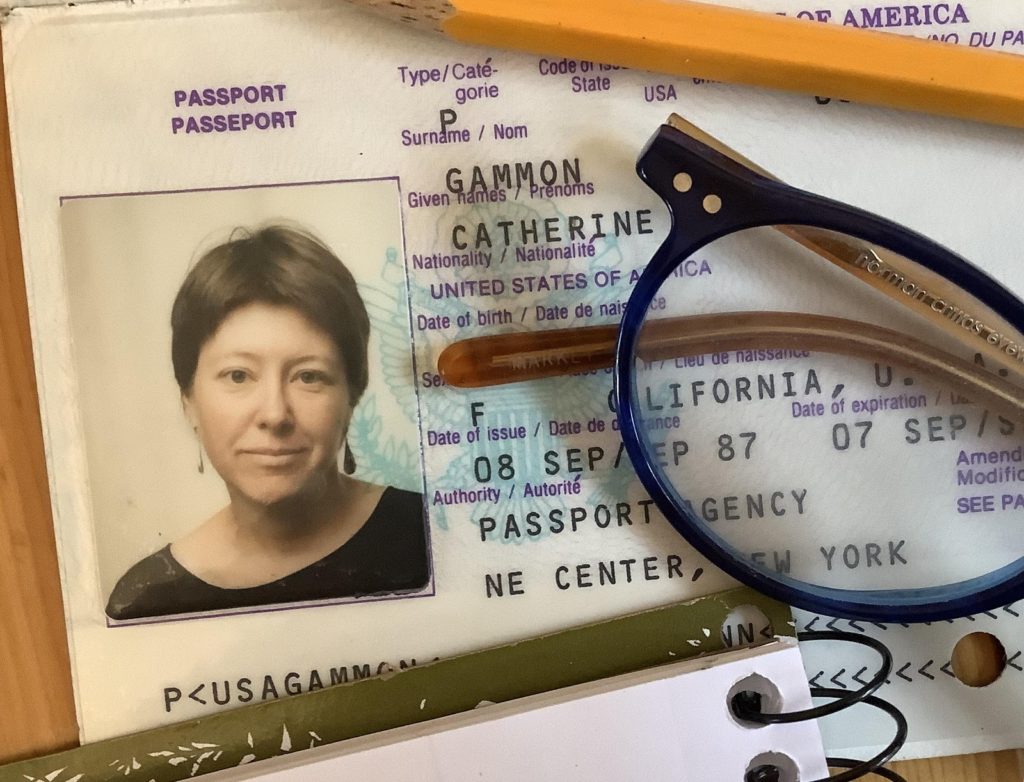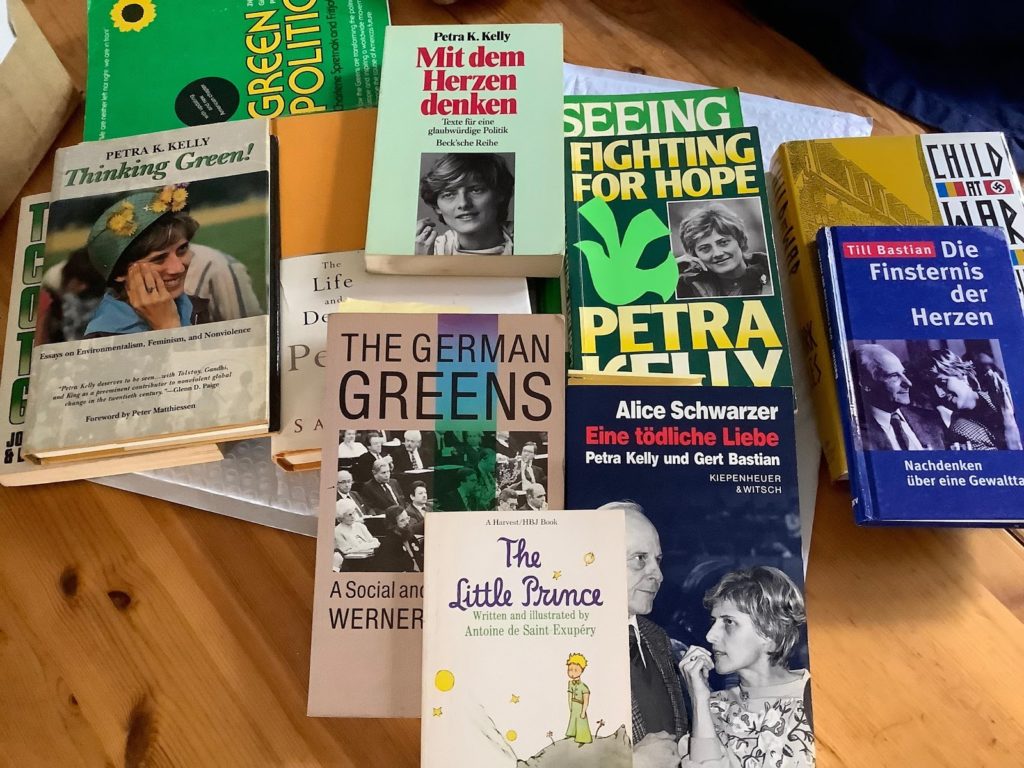Our Research Notes series invites authors to describe their process for a recent book, with “research” defined as broadly as they like. This week, Catherine Gammon writes about The Martyrs, The Lovers from 55 Fathoms Publishing.
+
1

When I first researched the life and work of Petra Kelly, I was preparing to write a book different from The Martyrs, The Lovers in every obvious way. An as-told-to biography, in collaboration with Petra, the book to come was meant to focus on her understanding of herself and her evolution as an environmental activist. As we were putting the elements of this project together, Isabel Out of the Rain, the first novel of mine to be published, was in production at Mercury House, due out the following year.
From the beginning there were three agendas—the press wanted an inspiring personal narrative of eco-feminist spirituality, Petra wanted a political account that required less self-exploration from her (something between a hagiography and a call to arms, I find myself adding, but this is the fiction writer speaking), and as a fiction writer, I wanted a gathering of complex resources freely shaped, trusted, questioned, doubted, and existentially engaged with throughout the writing.
After a cordial meeting over dinner in Washington, D.C., we somehow managed to put together a proposal and a contract apparently agreeable to us all. The plan was to spend a month in Bonn during which I would have two hours with Petra daily, asking questions designed to evoke stories and recording her responses, all to provide the raw material from which I would independently build the book. Still thinking like a fiction writer, I was preparing to probe depths and undercurrents at least as much as the more obvious historical and political forces.
My research began with reading to develop the interview questions. Much had been written in English about Petra and the Greens, and some of her own writing and speeches had been translated. Though nothing like fluent, I had studied several years of German in college, and my reading ability was strong enough to come back to life with practice, so I was also able to read the relevant publications available only in German.
+
2
Petra Kelly was roughly my age and, although born in Germany, had lived in the United States as an American high school and college student through most of the 1960s, that pivotal decade in our history and in the life of my generation. After the assassinations of 1968 and the election of Richard Nixon, she rejected the US and returned to Europe. Along with her tireless advocacy, her joy in creative protest, and the intensity of her personal presence, her intimacy with American culture and her fluency in English contributed to her rise to international political stardom in the early 1980s as the charismatic leader of the first successful wave of the then West German Greens.
I had studied German literature and philosophy in college, in addition to the language, and my own oppositional politics were haunted by what I understood of the Holocaust and its aftermath. I did not want to be what in those days we called “a good German.” Beyond and before the reading I’d done in preparation, I felt personally connected to Petra’s story, and knowingly and unknowingly drew my questions for and about her as much from my own life and observations as from hers. I expected our conversations to open floodgates of narrative and dramatic self-revelation. I never stopped thinking like a fiction writer.
“It is the innocence which constitutes the crime,” James Baldwin writes in The Fire Next Time.
+
3
With my thorough background reading and naive sense of affinity as the starting point, I prepared and structured my interview questions (long, many faceted, annotated, and dense, as I recall), sent them to Petra months in advance, and prepared to go to Bonn. My partner of those days, an activist and journalist, would travel to Germany with me, developing a story of his own while I worked with Petra.
Once we got to Bonn, almost before it began, the project fell apart.

Petra’s resistance to the personal character of the projected book came into direct conflict with the working schedule I understood we had agreed to and with the book I was contracted for and was willing to write. After a long night and day of consideration, I knew I had to withdraw from the project. Several necessary phone calls later, the editor and my agent supported me in this decision. In a final meeting, Petra and her ever-present partner Gert Bastian insisted on changing my mind. Refusing them, sitting with them for hours and refusing, remains, decades later, among the most difficult challenges I have ever met.
I had no plans to do anything with the research I had put into the abandoned book. A few months later, after my partner and I were back in New York, when approached to do a thousand paid words on Petra Kelly, I declined.
I never intended—and intended never—to write about her.
As the narrator of The Martyrs, The Lovers says so gently of herself and Jutta Carroll, Petra and I had disappointed one another.
+
4
Two years later, shortly after I moved from Brooklyn to begin teaching fiction writing at the University of Pittsburgh, my partner, still in New York, called—just as in the novel—to tell me the news of Petra’s death with Gert, their bodies undiscovered for three weeks.
From that moment on, the novel became inevitable.
+
5
“Remember—truth always sounds incredible: truth is the true fiction”—these words from Heinrich Böll are the epigraph to the Notes at the end of The Martyrs, The Lovers.
As the novel’s narrator says, The Martyrs, The Lovers is a work of fiction, invention orbiting fact. Although I drew Jutta and Lukas loosely from the lives and reported histories of Petra Kelly and Gert Bastian, nothing in their fictional world should be taken as revealing or reflecting, directly or indirectly, the living or the dead.
Extensive and bibliographic, the Notes invite the reader interested in the recorded facts, or curious about their transformation, to investigate the same nonfiction sources that provided much of the “fact” the fiction orbits. (“Fact” in quotation marks because even in the world of nonfiction, facts are elusive, reports contradict.) Along with my brief acquaintance with Petra and Gert, the many books and articles the Notes cite and discuss prepared the way for my imagination of Jutta Carroll and her world.

+
6
After Petra Kelly and Gert Bastian died, my research began again, first with newspaper reports, obituaries, and brief remembrances published in the days and weeks following the discovery of the bodies, then with several journalistic biographies published almost as immediately.
As my sense of the novel grew, so did the reading, to include studies of migraine and Hildegard von Bingen, analyses of the Holocaust, Auschwitz, the infamous Nazi doctors, histories of the US bombing of Hiroshima, the Chinese occupation of Tibet, the 1957 nuclear accident at Windscale and its consequences, accounts of the rise of neo-Nazis in West Germany and the Lyndon LaRouche organization in the US, the 1967 march on the Pentagon and other antiwar protests, the assassinations of King and the Kennedys, formational texts by Gandhi, Rosa Luxembourg, Goethe, and Alexandra Kollontai, photographs from Life magazine, and finally The Little Prince.
Some details required research of another sort—an interview with a police detective to clarify my understanding of the forensic conclusions of 1992, a German reader early on. Even the “texts” that arose from my own life—the memory of those images from Life, for example—called for research, to verify, revise, or expand beyond memory.
+
7
The nonfiction written about Petra Kelly and Gert Bastian in the wake of their deaths often presents invented moments that only the two who are dead could have known—fictionalizing while claiming to offer fact. Since I was writing fiction, I knew from the beginning that I would do the opposite, offering only provisional inventions and contradictory possibilities.
I did the work of this book, the research and the writing, primarily during the 1990s, almost ancient history now as far as the culture is concerned—and still the seeds of every challenge we face in the 21st century are evident in these lives, both the historical lives and the fictional ones.
In the novel of Jutta and Lukas there are no definitive answers—about their lives, their deaths, or their world—even as their questions persist in ours.
As the narrator admits from the outset, this writing too must fail.
+++
Catherine Gammon is author of the novels The Martyrs, The Lovers; China Blue; Isabel Out of the Rain, and Sorrow. Her fiction has appeared in Ploughshares, Kenyon Review, Iowa Review, New England Review, Cincinnati Review, and The Missouri Review, among many others, as well as online at The Blood Pudding, Vol. 1 Brooklyn, and Fractured Lit. Her work has received support from the National Endowment for the Arts, the New York Foundation for the Arts, the American Antiquarian Society, the Fine Arts Work Center in Provincetown, Virginia Center for the Creative Arts, Yaddo, and Djerassi. From 1992 through 2000, Catherine taught in the MFA writing program of the University of Pittsburgh, before leaving for residential Zen training at San Francisco Zen Center, where she was ordained a priest in 2005. More at Twitter @nonabiding / Instagram @catherinegammonwriter / www.catherinegammon.com / www.littsburgh.com/qa-catherine-gammon-author-of-china-blue-and-sorrow/.